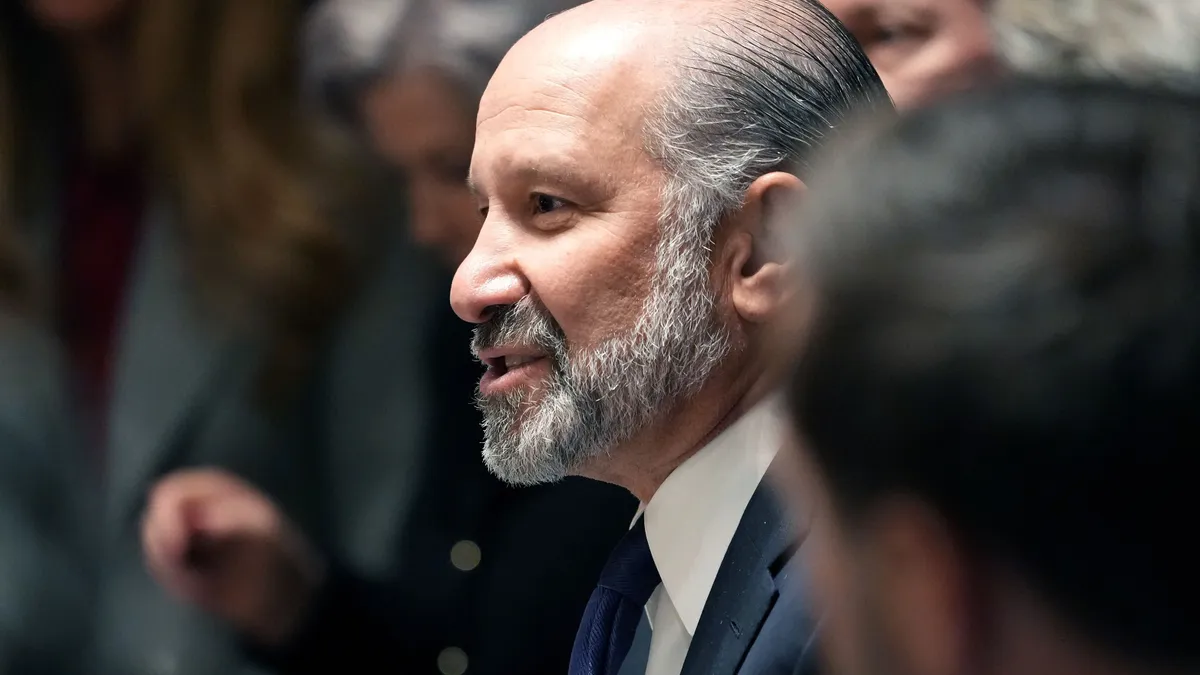John Luna, a trained audiologist, has worked at some of the leading innovators in the space and once owned a chain of audiology clinics in the U.S. A life spent in the industry has given him an understanding of the consumers, the science and the business of hearing aids.
Nuheara, based in Perth, Australia, develops and manufactures medical and personal hearing devices, and theirs is the first self-fitting, air-conduction hearing aid to receive the Food and Drug Administration’s 510(k) clearance for sale over the counter in the U.S.
According to the U.S. National Institute on Deafness and Other Communication Disorders, fewer than 1 in 3 people over the age of 70 who could benefit from medical-grade hearing aids has ever used them. After Nuheara introduced its OTC devices this week, Luna discussed the devices and their market in an interview with MedTech Dive.
This interview has been edited for length and clarity.
MedTech Dive: What is the big innovation here with the OTC rule on hearing aids?
John Luna: The big change here is access for consumers, like your father, like my father, and like people in their 40s. The reality is what we used to do prescriptively — where you would have to go to an audiologist, or a retailer or a physician, to access a test to access hearing aids — was very controlled, not only by the incumbents in the industry, but also, the rules and regulations laid out, on a state level, how somebody could buy them. This changes that now forever. As of October 17, 2022, a consumer with a perceived or diagnosed mild to moderate hearing loss can purchase over the counter the same technology, or similar technology that is FDA regulated and has clear FDA guidance around it, that they would have had to spend $4,000 to $8,000 for. For somebody that's diagnosed already, and has hearing aids and knows that they're in that range, they now have choices between $200 and $3,000.
How big is the market that we're talking about here? And how many players do you think will eventually enter it?
The projections to 2029 are that it will grow by $6 to $8 billion. If you think about the size of the market, 85% of the folks that currently have a need, or have an awareness that they have a need, don't own a solution. They don't own a hearing aid. If we can reach them, and see an incremental growth in ownership of those who have perceived mild to moderate hearing loss, then the market will grow organically and could outgrow the analysts’ predictions. Right now that’s about a $10.2 billion market, and they're saying that it'll be a $17.7 billion market by 2029.
The number of entrants in the market? It's not an easy market to enter. If you're an OTC product, you're a medical device, and you have to follow the same rules, so … I think more people [will] enter the market, it's a huge market.
Congress first asked the FDA to set rules for OTC hearing aids more than five years ago. But they only took effect last month. Why so long?
[The OTC bill] was signed into law in August of 2017, by President Trump. And then it went through a period with nothing done on the rule, except for in the background, although there were a lot of hearings and professional groups, and stakeholders did presentations and a lot of scientific research behind how this was going to be crafted. And when COVID hit, it was just one on the long list of things that were put on hold. President Biden, in July of this year, stated that he would give them 120 days to publish the rule. So there's a lot behind this, a huge bipartisan effort in Congress really made this happen with the FDA.
We've seen Sony come in, Bose, it seems that a lot of consumer electronics companies have come in and you've decided to partner with HP. What makes that a better way to go forward?
When you're talking about an unassisted sale in retail, brand recognition and consumer confidence are key. We chose HP because HP is the second most recognized and reputable computer brand in the U.S., other than Apple. We have experience in the consumer electronics, wearable world with audio, and the fact that we have had experience with them in the past as an OEM manufacturer for the elite buds for their computer group. We wanted to have, as an Australian company, brand recognition in the US, [so when] a consumer walks into a pharmacy or an electronics store and they have all these choices, [they] recognize HP, and it's powered by Nuheara, and it's our technology, and we're building the product.
Will OTC hearing aids spread globally?
The U.S. is the tip of the iceberg. Honestly, there's 1.5 billion people that show they have a need, with mild to moderate hearing loss. And we don't have a solution. If you look at countries like China and Japan, you'll see that the aging population, over 60 years old, continues to grow. People are more active, they're living longer. And they're more social. And with COVID, there was a lot more uptake of technology by the older folks, including my parents, who didn't FaceTime before and didn't do Zoom calls. So there's cool tech within the hearing field that now is available over the counter at a much lower price.
What was the technological journey for your company developing the OTC device from what you already have?
It really started in 2018 when we did a study on our hearing test and how it fits someone's hearing needs, called Ear ID, at the National Acoustic Laboratories [in Sydney, Australia]. When we went to move from consumer electronics with all [those] learnings, we had been in retail and direct to consumer for the last five years. And then [we studied] the growth that we saw and learnings over the COVID time period and how consumers were interacting with the technology. We took all of that in. To validate our self-fitting aspect, we were going off a predicate which was Bose, and we had to prove that we were as effective as that, as well as substantially equivalent to a best-practice audiologist professionally fit hearing aid. For our 510(K) with the FDA, [we learned] what was going to be successful for all age groups within that mild to moderate hearing range and we submitted that to the FDA. When the rule was published in August of this year, we made the conscious decision to then submit our OTC labeling to the FDA for clearance, which we now understand was the first to be cleared as an OTC product for self-fitting, air conduction hearing.
Besides going into a big box store or a pharmacy, will these OTC hearing aids be an alternative for the professionals to sell in their practice?
One thing the rule was very clear on is that while you don't have to be a licensed practitioner — an audiologist, ENT [ear, nose and throat physician], or hearing aid retailer — to have to sell the product like you would in the prescriptive world. They can sell OTC. We're working with some of the groups that have retail hearing aid clinics, and we are also going to be in over 3,000 ENT offices in the United States. Independent pharmacists obviously have a need and it's of value to them to compete with the chain pharmacies in their communities and they can offer these as well.
With consumers not getting fitted by a professional, how do they know which OTC hearing aid is right for them?
Return privilege and warranty is what you want to look at when you purchase the product. Especially if you're buying for somebody else, you want to make sure that they have time to try it. It takes time to get used to hearing. Not only [are you] hearing your own voice differently, but you're hearing sounds in the world that you may not have noticed. It takes the brain a little bit of time, so you want to make sure you have at least a 30-day return window, so you can try them throughout your day.
As adoption rises, will mass production bring down the unit cost and price?
That's our goal, although I'll say with semiconductor and supply chain and other component issues over the last few years, and with the rising cost of labor, it's difficult to do that. We’ve partnered with Realtek, a Taiwanese semiconductor company on our own chip. There's only one company that has their own chip and that's Apple, the rest of us use and bring together different components from different chipsets across the world.


















